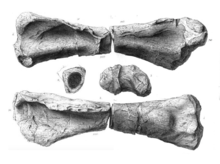Duriatitan
| Duriatitan Temporal range: Late Jurassic,
| |
|---|---|

| |
| Holotype humerus seen from two different angles | |
| Scientific classification | |
| Kingdom: | Animalia |
| Phylum: | Chordata |
| Clade: | Dinosauria |
| Clade: | Saurischia |
| Clade: | †Sauropodomorpha |
| Clade: | †Sauropoda |
| Clade: | †Macronaria |
| Clade: | †Titanosauriformes |
| Genus: | †Duriatitan Barrett, Benson & Upchurch, 2010 |
| Species: | †D. humerocristatus
|
| Binomial name | |
| †Duriatitan humerocristatus (Hulke, 1874 [originally Cetiosaurus])
| |
| Synonyms | |
|
Ceteosaurus humero-cristatus Hulke 1874 | |
Duriatitan is a genus of titanosauriform sauropod dinosaur that lived in the Late Jurassic in what is now England. The holotype specimen of Duriatitan, BMNH 44635, is a partial left upper arm bone which was found by R.I. Smith near in the lower Kimmeridge Clay from Dorset. The type species, D. humerocristatus, was described in 1874 by John Hulke as a species of Cetiosaurus. The specific name refers to the deltopectoral crest, crista, on the upper arm bone, humerus.[1] The specimen was assigned to its own genus by , and in 2010. The generic name is derived from the Latin name for Dorset, Duria, and Greek Titan.[2] Thomas Holtz estimated its length at 25 meters (82 ft).[3]
References[]
- ^ Hulke, J. W. (1874). "Note on a very large saurian limb-bone adapted for progression upon land, from the Kimmeridge clay of Weymouth, Dorset". Quarterly Journal of the Geological Society of London. 30 (1–4): 16–17. doi:10.1144/gsl.jgs.1874.030.01-04.17. S2CID 129254662.
- ^ Paul M. Barrett, Roger B.J. Benson and Paul Upchurch (2010). "Dinosaurs of Dorset: Part II, the sauropod dinosaurs (Saurischia, Sauropoda) with additional comments on the theropods". Proceedings of the Dorset Natural History and Archaeological Society. 131: 113–126.
- ^ Holtz, Thomas R. (2012). "Holtz's Genus List" (PDF).
| Wikispecies has information related to Duriatitan. |
- Brachiosaurs
- Late Jurassic dinosaurs of Europe
- Fossil taxa described in 2010
- Fossils of England
- 1874 in England
- 2010 in England
- History of Dorset
- Sauropodomorph stubs
- England stubs












